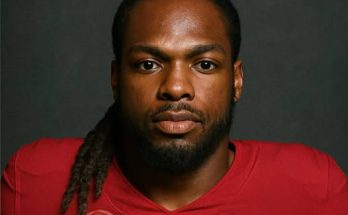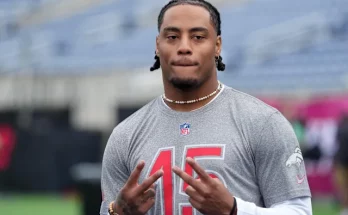Arthur Smith didn’t mince words. When asked about the New York Jets’ offensive strategy heading into the 2025 NFL season, the Jets’ new offensive coordinator offered a clear and biting response: “We didn’t go get Aaron Rodgers and DK Metcalf to run the wishbone.” The comment, laced with sarcasm but packed with intent, sent a jolt through the NFL community. It wasn’t just a dismissal of outdated offensive concepts—it was a signal of what’s coming in New York. The Jets, long starved for relevance and stability, are going all in on firepower, aggression, and modern offensive football. For Smith, this is about maximizing talent, not minimizing risk.
Rodgers’ return from the torn Achilles he suffered just four snaps into the 2023 season is already one of the most anticipated storylines in football. Now 41, Rodgers has nothing left to prove individually. He’s a first-ballot Hall of Famer with four MVPs and a Super Bowl ring. What he does have left, however, is legacy—unfinished business in New York and a team around him that might just be built to make a run. Pairing Rodgers with DK Metcalf, who arrived in a blockbuster offseason trade from the Seahawks, shows how serious the Jets are about chasing greatness. And for Smith, the architect charged with turning talent into touchdowns, this is a blank canvas begging for bold strokes.
The wishbone offense, for the uninitiated, is a relic of a bygone era—an option-heavy, run-dominant scheme more at home in college football during the 1970s than in the modern NFL. So Smith’s comment wasn’t just a joke. It was a sharp reminder that this team isn’t going to be conservative, predictable, or backward-thinking. They’re not going to keep the Ferrari in the garage. Rodgers is expected to have full control at the line of scrimmage, with freedom to adjust routes, shifts, and protection. With Metcalf and Garrett Wilson on the outside, plus emerging tight end Jeremy Ruckert and second-year running back Israel Abanikanda ready to explode, this offense is being engineered for verticality and versatility.
Smith’s own coaching past is a blend of power football and adaptability. His most notable success came in Tennessee, where he helped revive Ryan Tannehill’s career and made Derrick Henry the league’s most feared back. But critics argue that his run-heavy approach in Atlanta over the past three seasons stifled the Falcons’ growth and limited young skill players like Kyle Pitts and Drake London. His tenure with the Falcons was uneven—sometimes brilliant, sometimes baffling—but Smith has always shown an ability to tailor schemes to talent. The problem in Atlanta, many believe, wasn’t scheme—it was the quarterback. That’s not an issue he’ll have in New York.
The challenge now is integration. Rodgers hasn’t played in a real NFL game since early September 2023. He’s coming off a major injury and entering his 20th professional season. Meanwhile, Metcalf is transitioning from Seattle’s West Coast-based offense into a scheme that will ask him to read defenses more and run a wider variety of routes. Timing between quarterback and wide receiver is everything, and it doesn’t happen overnight. Still, early reports from Jets minicamp are glowing. Metcalf looks energized, Rodgers looks sharp, and the two have reportedly been working out together in the offseason to accelerate chemistry. Their connection could be deadly, especially in the red zone, where Metcalf’s size and strength are nearly impossible to defend one-on-one.
But Smith is looking beyond just highlight-reel plays. His offensive vision is built on balance and manipulation. With Rodgers’ pre-snap IQ and ability to dissect defenses, the Jets will be able to disguise intentions, run layered route combinations, and keep opponents guessing. Expect to see more play-action, especially out of shotgun, more pre-snap motion to identify coverages, and more tempo shifts to throw off rhythm. The Jets are preparing to dictate terms rather than react. And that, more than any single play or philosophy, is what separates contenders from pretenders in the modern NFL.
The acquisition of Metcalf was more than just a splash move. It was a solution to a glaring problem. While Garrett Wilson is a budding star and former Offensive Rookie of the Year, he’s not built to absorb double teams on every snap. Defenses began keying in on him in 2024, daring the Jets to beat them elsewhere. Now, with Metcalf opposite Wilson, that’s no longer possible. If teams roll safeties to Metcalf’s side, Wilson eats. If they focus on Wilson, Metcalf sees single coverage—and he’s been one of the league’s best in those situations throughout his career. This gives Smith the leverage to stretch the field horizontally and vertically, opening up the middle for slot receivers and tight ends.
Still, with great talent comes great pressure. There’s no hiding behind rebuilding timelines or development curves anymore. The Jets, under head coach Robert Saleh, know they have a narrow window. Rodgers could retire at any moment. Injuries could strike. Cap space won’t stay friendly forever. That’s why they’ve built this team to win now. Smith’s hire is part of that urgency. He’s a proven play-caller with playoff experience and a reputation for maximizing quarterback efficiency. If he succeeds, the Jets could make their deepest postseason run since the Joe Namath era. If he falters, this could be another case of wasted potential in a franchise that has seen too many.
And yet, Smith seems undeterred by the pressure. In fact, he seems motivated by it. His candid statement about avoiding the wishbone wasn’t just about scheme—it was about mindset. This is a team that wants to dominate, not manage. A team that wants to score 30 points, not win 17-14 slogs. A team that knows the NFL is evolving, and refuses to be left behind. Smith has spoken at length about using analytics more, about taking calculated risks, and about adapting to game flow rather than sticking to rigid play scripts. That flexibility, combined with the weapons at his disposal, could make the Jets one of the most fun—and fearsome—offenses in the league.
There will be hiccups, of course. Early games could feature miscommunications, penalties, or missed opportunities as timing builds. Rodgers has to prove his Achilles can handle a full season. Metcalf has to adjust to a new city, new quarterback, and new expectations. But the upside is undeniable. This isn’t a team hoping to make the playoffs. This is a team expecting to win playoff games, expecting to challenge the likes of Kansas City, Baltimore, and Buffalo, and expecting to be part of the Super Bowl conversation deep into January.
Arthur Smith is now a central figure in that pursuit. His playbook, his calls, his adjustments—they’ll all be under a microscope. Every third-and-long conversion, every red zone stall, every blown lead will be dissected and debated. But for now, he has the trust of his quarterback, the backing of his head coach, and a locker room full of elite athletes hungry for success. It’s a promising formula.
Ultimately, the Jets’ 2025 season won’t be defined by scheme alone. It’ll be defined by execution, health, resilience, and the unrelenting push for something this franchise has craved for decades: a shot at greatness. Smith knows that. Rodgers knows that. Metcalf knows that. And if the trio can stay healthy, stay aggressive, and stay united in their approach, the Jets might just deliver the kind of season their fans have only dreamed about.
And rest assured, it won’t look anything like the wishbone.



